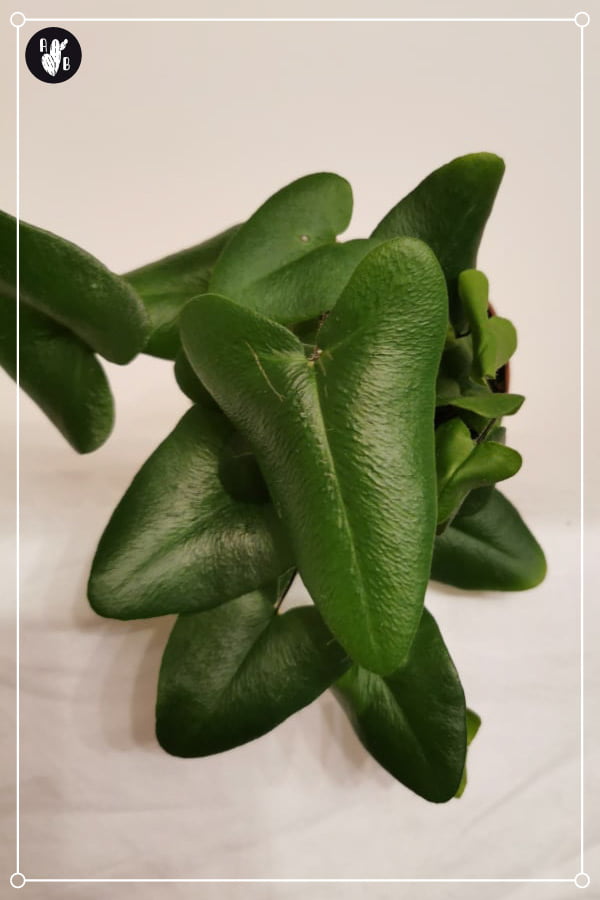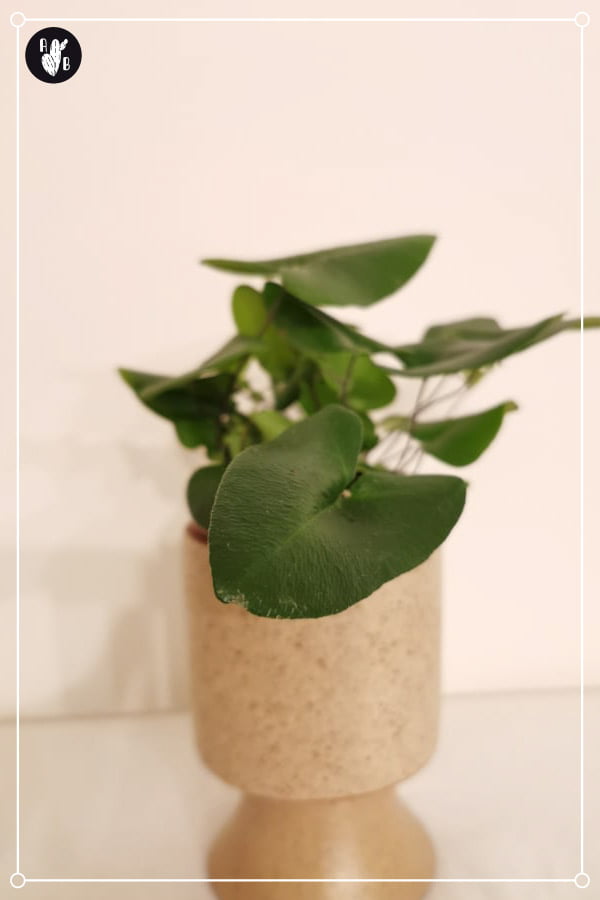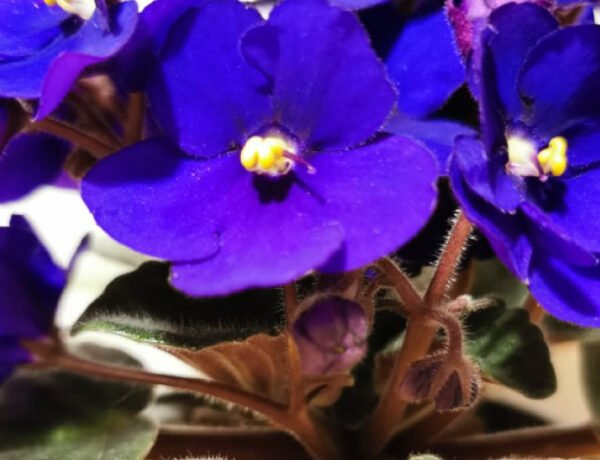The Heart Leaf Fern (Hermionitis arifolia) is a charming epiphytic dwarf fern native to Southeast Asia, known for its distinct heart-shaped leaves. These elongated, dark green leaves give the plant its unique and attractive appearance. Despite its petite size, the Heart Leaf Fern boasts relatively large leaves, setting it apart from other fern varieties.
The stems of this fern exhibit a nearly black color with a dry, firm, and wood-like texture. Unlike most ferns, the Heart Leaf Fern’s new leaves do not unfurl in a typical fashion. Instead, they gradually mature into their final, distinctive heart-shaped form.
In terms of care, as most ferns out there, this one loves its humidity, so if you can ace that part, everything else is going to be easy. Now, let’s see what it actually needs to thrive and mature!
Table of Contents
1. General Information
| Scientific name: | Hemionitis Arifolia |
| Common names: | Heart Leaf Fern, Heart-Shaped Fern |
| Native to: | Southeast Asia |
| Toxicity: | Non toxic to cats, dogs, or humans |
| Category: | Dwarf Fern |
| Height: | 6-8 inches (15 – 20 centimeters) |


2. Essential Care & Growing Tips for Heart Leaf Fern
Caring for Heart Leaf Fern requires a bit more attention than some other plants (as most ferns do). However, with a solid understanding of its needs, you can definitely help it thrive.
» Watering
Heart Leaf Ferns prefer consistently moist but not waterlogged soil. Water your plant when the top 1 – 2 inches (2.5 to 5 cm) of soil feel dry to the touch. Using room-temperature, filtered, or rainwater can prevent issues like leaf-tip browning, which can be caused by chemicals or minerals found in tap water.
If the leaves start to curl, it’s a signal that the plant needs more water. However, avoid overwatering, as its shallow root system makes the fern vulnerable to root rot.
» Lighting
As an epiphytic plant, the Heart Leaf Fern thrives in bright, indirect sunlight or dappled shade. Although it can adapt to low light conditions, its growth may be slower and less vibrant in such environments.
Keep the plant away from direct sunlight, as the intense rays can damage the delicate fronds and hinder the fern’s overall growth and health.
» Soil
The ideal soil composition for a Heart Leaf Fern includes a mix of organic matter, such as peat moss, leaf mold, and compost, combined with perlite or vermiculite to ensure adequate aeration and moisture retention.
A slightly acidic to neutral pH range of 5.5 to 6.5 is preferable for promoting healthy growth and development. As these ferns are sensitive to waterlogged conditions, it is important to maintain the right balance of moisture and drainage in the soil.
A loose, airy soil structure will encourage strong root growth and also prevent root rot.
» Temperature
Heart Leaf Ferns thrive in a temperature range of 60 to 75°F (16 to 24°C) during daytime hours and prefer a slight decrease during the night.
As they cannot tolerate frost, you should shield them from extreme cold or sudden temperature changes, which may cause stress or damage.
» humidity
As native plants of tropical regions, Heart Leaf Ferns require high humidity levels of around 60 to 80%. To maintain these levels, you can mist the plant regularly, place it on a tray with water and pebbles, or use a humidifier.
Grouping it with other high humidity-loving plants can also contribute to a more comfortable environment for your fern.
Its compact size and preference for high humidity make Heart Leaf Fern a great choice for a terrarium, especially for a closed or tropical setup.
» Fertilization
While Heart Leaf Ferns don’t require heavy fertilization, a balanced, water-soluble fertilizer applied at half strength every 4 to 6 weeks during the growing season can promote vibrant, healthy growth.
And don’t forget to always follow the manufacturer’s instructions, and avoid over-fertilization, as it can lead to foliage burn or other issues.
3. Heart Leaf Fern Maintenance & Propagation
» Repotting
Heart Leaf Ferns don’t mind being rootbound, so repotting is typically necessary every 2 to 3 years. Choose a new pot that is one size larger than the current one, and ensure it has proper drainage holes.
Gently remove the fern from its old pot, tease apart the roots if necessary, and plant it in the new container at the same soil level as before. Water the fern thoroughly after repotting to help it settle into its new home.
» Pruning
This part involves the removal of dead, damaged, or yellowing fronds to maintain the plant’s appearance and promote healthy growth. Use clean, sharp scissors or pruning shears to trim the fronds at their base, taking care not to damage the surrounding healthy foliage.
Regular pruning will encourage a more compact and attractive growth habit, as well as reduce the risk of pests and diseases.
» Propagation
While you can propagate Heart Leaf Ferns through spores, division is the easiest and fasted way to multiply your fern collection and should be done in spring, when the growth rate is at its peak.
To divide your Heart Leaf Fern, gently remove it from its pot and carefully separate the root ball into smaller sections, ensuring that each division has a healthy root system and at least a few fronds.
Plant each division into a new pot with well-draining, nutrient-rich soil, and water thoroughly.
Provide the appropriate care, such as maintaining optimal temperature, humidity, and lighting conditions, to help the divisions establish themselves and grow into healthy new plants.
4. Common Issues While Growing A Hermionitis Arifolia
Growing Heart Leaf Ferns can be relatively trouble-free with proper care, but there are a few common issues that may arise:
- Browning leaf tips: This issue can be caused by low humidity, inadequate water, or the use of tap water that’s high in minerals or chemicals. Maintain high humidity levels and use filtered or rainwater when watering the plant to prevent this problem.
- Yellowing leaves: Overwatering, underwatering, or poor drainage can lead to yellowing leaves. Make sure your fern’s soil is consistently moist but not soggy, and use a well-draining soil mix to prevent this issue.
- Slow growth or leggy appearance: Insufficient light can lead to slow growth or a leggy appearance. Provide your fern with bright, indirect light or dappled shade to promote healthy growth.
- Curling leaves: Insufficient water and low humidity levels are often the most common causes that lead to curling leaves in Heart Leaf Ferns. However, pests and over-fertilization may also be responsible for this issue. Thoroughly examine your fern for any signs of pest infestation and provide it with appropriate care to maintain its overall health.
5. Dealing With Pests And Diseases
Pests and diseases can sometimes affect Heart Leaf Ferns, although they are generally not a major concern when the plants are well-maintained. Some common pests and diseases that may impact these ferns include:
» Pests
- Aphids: These small insects can suck the sap from the fern’s leaves, causing curling, distortion, or yellowing. To control aphids, use insecticidal soap or neem oil, following the manufacturer’s instructions.
- Spider mites: Tiny, spider-like creatures that can cause speckling, yellowing, or curling of leaves. They often thrive in low humidity environments. Increase humidity around the plant and use insecticidal soap or miticides to control spider mites.
- Mealybugs: Small, cottony insects that can cause stunted growth, yellowing, or curling of leaves. Remove them manually using a cotton swab dipped in rubbing alcohol or apply insecticidal soap or neem oil.
» Diseases
- Root rot: Caused by fungi that thrive in overly damp conditions or poor drainage, root rot can lead to yellowing leaves, wilting, and ultimately, plant death. Prevent root rot by using well-draining soil, ensuring the pot has drainage holes, and watering only when the top 1 to 2 inches (2.5 to 5 cm) of soil feel dry to the touch.
- Fungal leaf spots: Caused by various fungi, leaf spots appear as discolored or necrotic areas on you fern’s fronds. To prevent and control leaf spots, maintain good air circulation around the plant, avoid overhead watering, and remove any affected leaves promptly. Fungicides can be used if the problem persists.
Conclusion
Heart Leaf Ferns (Hemionitis arifolia) are attractive and delicate plants that can make a beautiful addition to your indoor garden or terrarium.
By providing the appropriate temperature, humidity, lighting, and watering conditions, along with proper soil composition, you can ensure that your Heart Leaf Fern remains healthy and vibrant.
Paying attention to common issues such as curling leaves, pests, and diseases, and addressing them promptly, will help your fern become a long-lasting addition to your indoor garden.






No Comments